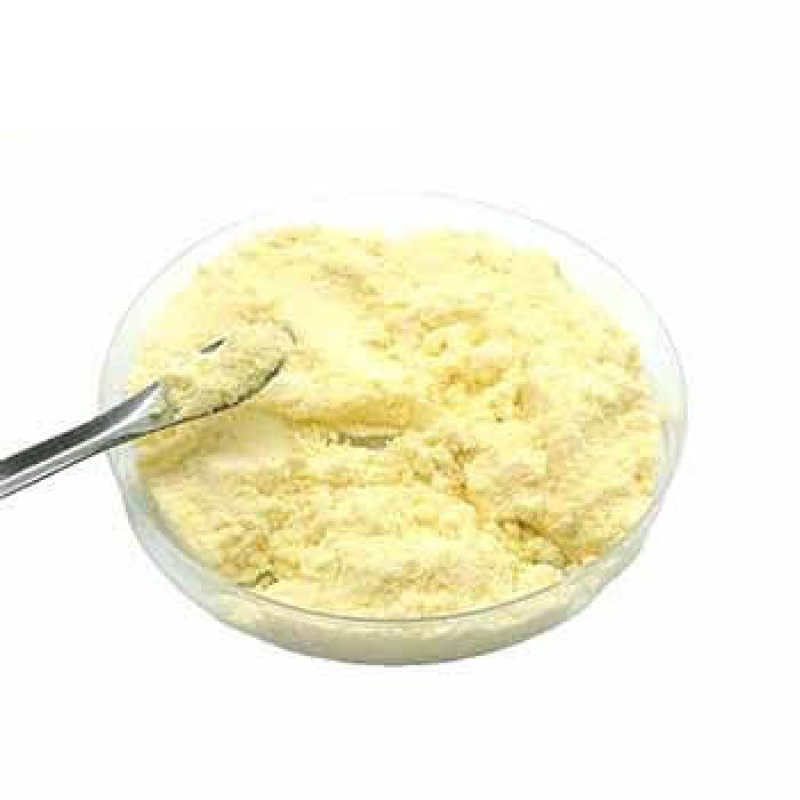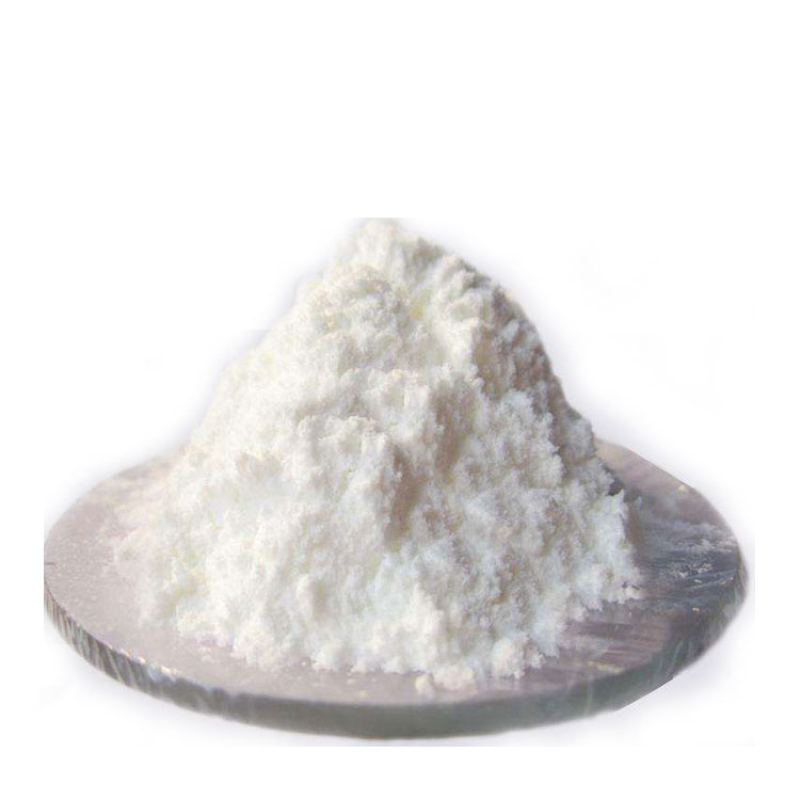Products Description of 6-Fluoronicotinic acid CAS#403-45-26-Fluoronicotinic acid is a pyridine compound, which is often used as a pyridine intermediate and a pharmaceutical intermediate.
Contact Now
Products Description of Flumethrin CAS#69770-45-2The industrial product is a clear brown liquid with a slight special odor. The specific density d is 1.013, and the vapor pressure is 1.33×10-8Pa (20°C). It is insoluble in water, but soluble in organic solvents such as methanol, acetone, and xylene.
Contact Now
Products Description of Dehydroacetic acid CAS#520-45-6DHA is widely found in many deep-sea fish oils, as well as in marine algae and some terrestrial plants. DHA is an ω-3 type unsaturated fatty acid and an essential fatty acid for the body. mp44℃. It is very unstable to light, oxygen and heat, and is easily oxidized and cracked, so antioxidants should usually be added.
Contact Now
Products Description of Titanium tetrachloride CAS#7550-45-0Titanium tetrachloride is the most important titanium halide and an important raw material for the production of titanium sponge and chloride-process titanium dioxide. Pure titanium tetrachloride is a colorless, transparent, high-density, non-conductive liquid with a chemical formula of TiCl4 and a relative density of 1.726. The melting point is -25°C and the boiling point is 136.4°C. It has a pungent sour taste and is easily hydrolyzed, generating white smoke in humid air. It dissolves in water and decomposes at the same time.
Contact Now
Products Description of Zinc bromide CAS#7699-45-8Zinc bromide is a chemical substance with the chemical formula ZnBr₂. It is a salt inorganic substance and is easily soluble in water.
Contact Now
Potassium clavulanate CAS# 61177-45-5Product Overview:Potassium Clavulanate, also known as CLAVULANIC ACID POTASSIUM SALT with the CAS#61177-45-5, is a potent β-lactamase inhibitor that is revolutionizing the way we combat bacterial infections in the industrial pharmaceutical sector. As a key component in the synthesis of advanced antibiotics, our Cellulose Clavulanate is designed to meet the rigorous demands of modern manufacturing processes.Market Relevance:In the competitive landscape of the pharmaceutical industry, the need for effective antibacterial agents is paramount.
Contact Now
Products Description of N-ETHYLFORMAMIDE CAS#627-45-2Used for liquid crystal intermediates, LCD stripping agent raw materials, pharmaceutical intermediates, etc.N-ETHYLFORMAMIDE Chemical PropertiesMelting point -60.43°C (estimate)Boiling point 202-204 °Cdensity 0.950 g/mL at 20 °C(lit.)refractive index n20/D 1.432Fp 67°Cstorage temp. 2-8°Cform clear liquidpka16.49±0.23(Predicted)color Colorless to Light yellow to Light orangeBRN 1737860EPA Substance Registry SystemFormamide, N-ethyl- (627-45-2)Safety InformationSafety S
Contact Now
Products Description of 2-Amino-6-chlorobenzoic acid CAS#2148-56-32-Amino-6-chlorobenzoic acid is a reactive compound that can be used as an antimicrobial agent. It binds to the active site of enzymes and inhibits their function, thereby preventing bacterial growth. It has acidic properties, which may be due to its ability to act as a dehydrating agent to hydrolyze esters.
Contact Now
Products Description of [1,2,4]TRIAZOLO[1,5-A]PYRIMIDINE-2-CARBOXYLIC ACID CAS#202065-25-6[1,2,4]Triazolo[1,5-a]pyrimidine-2-carboxylic acid is a chemical.Molecular Formula is C6H4N4O2.[1,2,4]TRIAZOLO[1,5-A]PYRIMIDINE-2-CARBOXYLIC ACID Chemical Propertiesdensity 1.79±0.1 g/cm3(Predicted)form powderpka-4.67±0.41(Predicted)color CreamSafety InformationHazard Codes XiRisk Statements 43Safety Statements 36/37HazardClass IRRITANTHS Code 2933998090Product Application of [1,2,4]TRIAZOLO[1,5-A]PYRIMIDINE-2-CARBOXYLIC ACID CAS#202065-25-6[1,2,4]Triazolo
Contact Now
Products Description of 6-CHLOROIMIDAZO[1,2-B]PYRIDAZINE-2-CARBOXYLIC ACID CAS#14714-24-06-Chloromidazo[1,2-B]pyridazine-2-carboxylic acid can be used to prepare compounds which can be used as active pharmaceutical substances, in particular Trk antagonists, i.e. they block the intracellular kinase activity of Trk, e.g. TrkA (NGF) receptors. Tropomyosin-related kinases (Trks) are a family of receptor tyrosine kinases activated by neurotrophic factors. Trks play an important role in pain perception and in tumor cell growth and survival signaling.
Contact Now
Products Description of Pyrophosphoric acid CAS#2466-09-3Pyrophosphoric acid is a colorless needle-shaped crystal or a colorless viscous liquid. It forms crystals after long-term storage and is colorless glassy. Pyrophosphate has strong coordination properties. Excess P2O74- can dissolve insoluble pyrophosphates (Cu2+, Ag+, Zn2+, Mg2+, Ca2+, Sn2+, etc.) to form complex ions, such as [Cu(P2O7)2]6-, [Sn(P2O7)2]6-, etc. It is often used as a catalyst in industry to prepare organic phosphates, etc. Pyrophosphate meets silver salt to obtain white silver pyrophosphate precipitate.
Contact Now
Products Description of Optical brightener OB-1 CAS#1533-45-5Fluorescent whitening agent OB-1, 2,2-(4,4-diphenylethylene) bisbenzoxazole, is a yellow crystalline substance with a melting point of 359-362℃, insoluble in water, odorless, stable performance, and a maximum absorption spectrum wavelength of 374nm. It has strong fluorescence and a fluorescence emission wavelength of 434nm.
Contact Now
Products Description of M-Phenylenediamine (m-PDA) CAS#108-45-2Meta-phenylenediamine is an important raw material for organic synthesis. It is mainly used as a dye intermediate to produce basic orange, basic brown G, direct sunfast black G and other dyes. It is also used as fur dye and epoxy resin. It is used as a curing agent, cement coagulant, mordant, color developer, etc.
Contact Now
Products Description of Formic acid CAS#64-18-6 Formic acid is an important chemical raw material. It was first discovered by Fisher in 1670. A.S.Marggret first produced pure formic acid in 1749.It was first discovered by distilling red ants, hence the name formic acid. Formic acid is widely found in nature, such as in the secretions of red ants, bees, caterpillars, etc., in the leaves and roots of plants, and in fruits. It is the simplest carboxylic acid. Compared with other fatty carboxylic acids, it has a special structure and is more acidic.
Contact Now
2-Bromo-6-methoxypyridine Chemical PropertiesBoiling point 206 °C (lit.)density 1.53 g/mL at 25 °C (lit.)refractive index n20/D 1.559(lit.)Fp 220 °Fstorage temp. Inert atmosphere,Room Temperaturepka-1.04±0.10(Predicted)form Liquidcolor Clear colorless to goldenInChIInChI=1S/C6H6BrNO/c1-9-6-4-2-3-5(7)8-6/h2-4H,1H3InChIKeyKMODISUYWZPVGV-UHFFFAOYSA-NSMILESC1(Br)=NC(OC)=CC=C1CAS DataBase Reference40473-07-2(CAS DataBase Reference)Safety InformationHazard Codes Xi,T,XnRisk Statements 36/37/38-20/21/22Safety Statements 26-36WGK Germany
Contact Now
Products Description of L-Threonic acid magnesium salt CAS#778571-57-6Magnesium L-threonate (MgT, pronounced "Mag T") is a chemical substance discovered by Professor Liu Guosong and a team from Tsinghua University and MIT.L-Threonic acid magnesium salt Chemical Propertiesstorage temp. Inert atmosphere,Room TemperatureInChIInChI=1S/2C4H8O5.Mg/c2*5-1-2(6)3(7)4(8)9;/h2*2-3,5-7H,1H2,(H,8,9);/q;;+2/p-2InChIKeyYVJOHOWNFPQSPP-UHFFFAOYSA-LSMILESC(C1=O[Mg+2]2(O=C(C(O)C(O)CO)[O-]2)[O-]1)(O)C(O)COProduct Application of L-Threonic acid magnesium salt CAS#778571-57-6Magnesium, as a
Contact Now
Products Description of (R)-(-)-2-Methylpiperazine CAS#75336-86-6 White to light yellow crystalline solid.
Contact Now
Products Description of 3-Pyridazinecarboxylic Acid CAS#2164-61-63-Carboxypyridazine is a heterocyclic derivative that can be used as a pharmaceutical intermediate in pharmaceutical experimental research and pharmaceutical synthesis.3-Pyridazinecarboxylic Acid CAS#2164-61-6 Chemical PropertiesMelting point 200-209 °CBoiling point 404.2±18.0 °C(Predicted)density 1.403±0.06 g/cm3(Predicted)storage temp. Keep in dark place,Sealed in dry,Room Temperatureform solidpka3.65±0.10(Predicted)Safety InformationHazard Codes XiRisk Statements 36/37/38Safet
Contact Now
Products Description of Phosphorous acidCAS#13598-36-2Colorless crystals. Easily soluble in water and alcohol.Phosphorous acid Chemical PropertiesMelting point 73 °CBoiling point 200 °Cdensity 1.651 g/mL at 25 °C(lit.)vapor pressure 0.001Pa at 20℃Fp 200°Cstorage temp. 0-6°Csolubility DMSO (Slightly), Methanol (Slightly), Water (Sparingly)form CrystalspkapK1 1.29; pK2 6.74(at 25℃)Specific Gravity1.651color WhiteWater Solubility SOLUBLESensitive Air Sensitive & HygroscopicMerck 14,7346Stability:Stable.
Contact Now
Products Description of Methanedisulphonic acidCAS#503-40-2Methyl disulfonic acid is an important fine chemical product.
Contact Now
Products Description of Dinonylnaphthalenesulfonic acid CAS#25322-17-2Dinonylnaphthalenesulfonic acid is a chemical substance with the molecular formula C28H44O3S.Dinonylnaphthalenesulfonic acid Chemical PropertiesBoiling point 94-99 °Cdensity 0.852 g/mL at 25 °Crefractive index n20/D 1.465Fp 30 °Fstorage temp. 2-8°Csolubility H2O: insolubleCAS DataBase Reference25322-17-2(CAS DataBase Reference)EPA Substance Registry SystemNaphthalenesulfonic acid, dinonyl- (25322-17-2)Safety InformationHazard Codes F,Xn,NRisk Statements&nb
Contact Now
Products Description of 2-chlorobenzoic acid CAS#118-91-22-Chlorobenzoic acid, almost white coarse powder. The melting point is 142℃, and the density (20℃) is 1.5449/m3.
Contact Now
Products Description of 2-Hydroxynicotinic acid CAS#609-71-22-Hydroxynicotinic acid is an organic intermediate.
Contact Now
Products Description of 6-Bromo-2-Methylquinoline CAS#877-42-96-Bromo-2-methylquinoline is an organic chemical pharmaceutical intermediate. 6-Bromo-2-Methylquinoline CAS#877-42-9 Chemical PropertiesMelting point 101-105 °C (lit.)Boiling point 299.7±20.0 °C(Predicted)density 1.488±0.06 g/cm3(Predicted)storage temp. Sealed in dry,Room Temperaturesolubility Methanol[soluble in]solubility soluble in Methanolpka5.02±0.43(Predicted)form solidcolor GreyInChIKeySQRYQSKJZVQJAY-UHFFFAOYSA-NCAS DataBase Reference877-42-9(CAS DataBase Reference)NIST C
Contact Now










![[1,2,4]TRIAZOLO[1,5-A]PYRIMIDINE-2-CARBOXYLIC ACID CAS#202065-25-6](https://d3rnfhc14zcmdf.cloudfront.net/cdn/ff/oLGUsn18qGlr6xFpfvjw88ruuxs7GrtvunO9beYlPGM/1717583118/public/styles/chanpinzhutu/public/2024-06/photobank%20%282%29_1.jpg?itok=-1jJhH8M)
![6-CHLOROIMIDAZO[1,2-B]PYRIDAZINE-2-CARBOXYLIC ACID CAS#14714-24-0](https://d3rnfhc14zcmdf.cloudfront.net/cdn/ff/vbP0AMU1SZWoeuPOBqSMI1QHHcX8Iq0KlluvtoZIwQw/1717571201/public/styles/chanpinzhutu/public/2024-06/%E9%BB%84%E8%89%B2%E9%A2%97%E7%B2%92%20%283%29_0.jpg?itok=ni7182_2)






















